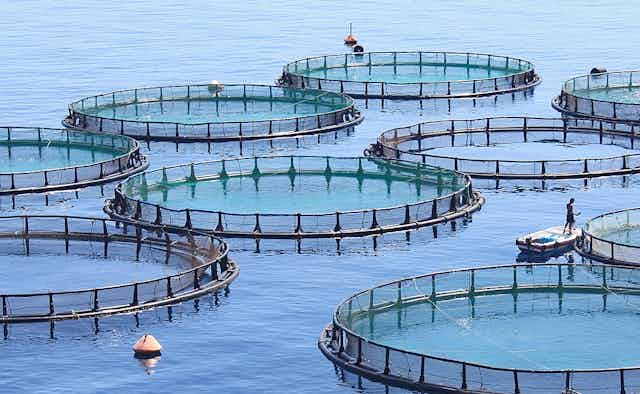More than seven billion people live on Earth today, of whom almost one billion do not have enough to eat. By 2050, our planet’s human population is likely to reach almost ten billion, an extremely challenging number of people to feed sustainably.
Oceans cover over 70% of the Earth’s surface, and many of the animals inhabiting them – like fish and shellfish – are a vital source of nutrition for societies across the globe. Managing this resource sustainably can help combat food shortages. But to give fishers and fish farmers an incentive to harvest the seas with long-term environmental health in mind, there needs to be consumer demand for sustainable production practices.
Our research, using data from German households, shows that certified sustainable farmed fish sell for slightly higher prices – suggesting that some consumers are indeed willing to pay more for a meal that’s gentler on the environment.
Previous work has looked at the prices of products of open-water fisheries. But studies investigating consumer preferences for sustainably farmed (not fished) seafood remain scarce, despite the fact that fish farms now contribute more seafood to people’s plates than open-water fishing.
In order to analyse how willing consumers are to pay more for sustainably produced farmed seafood, we analysed “price premiums”, or the price difference between sustainable and “standard” seafood products across supermarkets. This difference reflects consumer readiness to pay a higher price for a product different in some way from its typical equivalent.
To do this, we took advantage of ecolabelling schemes. Ecolabels have established themselves in the seafood market as a tool to help people differentiate between sustainably- and non-sustainably produced foods, by providing information about the food’s environmental impact.

The leading label helping to assure environmentally friendly production of farmed seafood – the Aquaculture Stewardship Council (ASC) label – was implemented in 2012. Its equivalent for open-water fisheries, the Marine Stewardship Council (MSC) label, was introduced in 1997.
Consumer preferences
There’s already a significant market for these products in countries across Europe. Just under three quarters of fresh, frozen and canned seafood sold in Dutch supermarkets now carries either the ASC or MSC label. And in the UK, MSC-labelled products made up over a third of supermarket seafood sales between 2019 and 2020. Money spent by UK consumers on MSC-certified fish alone in 2020 hit £1.3 billion.
Several studies provide evidence of price premiums associated with MSC-certified seafood. We were interested to see whether this trend would hold for ASC-certified seafood, too.
We assessed prices for the three most common farmed whitefish carrying the ASC label in Germany: pangasius, tilapia and rainbow trout. Across the board, we found price premiums for smoked, fresh, and canned fish relative to frozen fish.

Interestingly, we also found that on average, both ASC-labelled pangasius and tilapia fetch a price 6% above that of unlabelled products, while for ASC-labelled trout the price difference is even higher, at 9%. However, the variation in premiums for farmed fish appears to be lower than for ocean-caught fish, likely because of the fish farming is a more predictable method of production than open-water fishing, which is highly dependent on weather, legal restrictions and stock conditions.
Overall, our study indicates that consumers are willing to pay more for ASC-labelled farmed fish than for their non-labelled counterparts. This apparent willingness to pay for more sustainably produced seafood suggests that such consumers genuinely care about reducing the environmental impact of their diet, including lessening damage to ocean habitats and injuries to marine mammals, sea turtles and seabirds.
And the existence of this consumer demand for sustainable fish at a premium price could give retailers and farmers a powerful incentive to stock, and produce, more environmentally friendly products.

